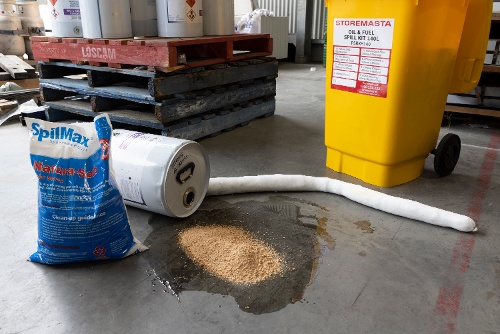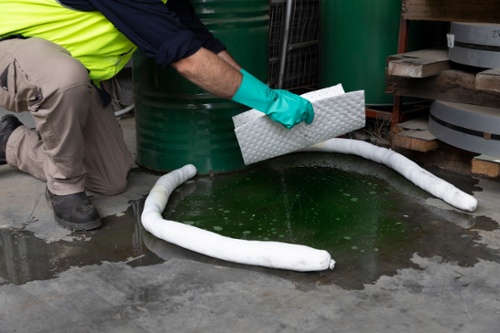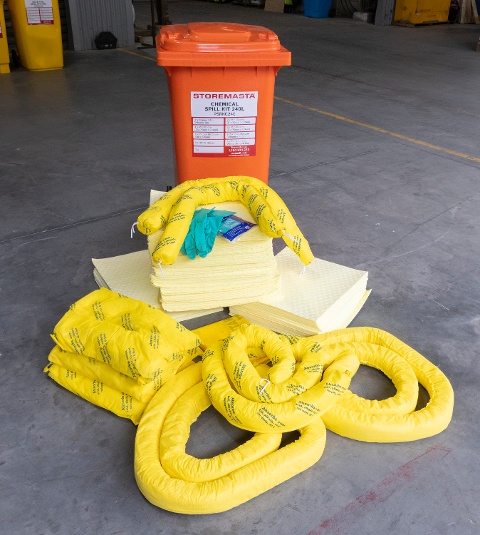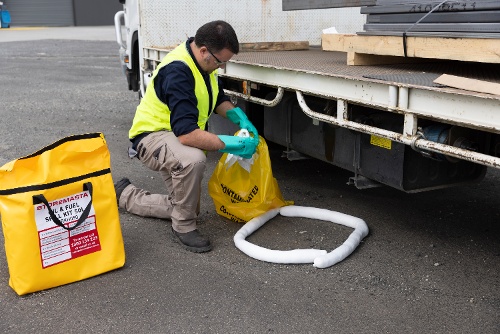Whether you’re a contractor, a supervisor or a business owner, if you carry any type of hazardous chemicals, you’ll need to develop a Spill Response Plan. As part of that spill response, you’ll need to place spill kits in your vehicles and workplace, to help your staff protect themselves and the business from the risks associated with hazardous chemical spills. But now that you’re considering the types and quantities of spill kits that you’ll need, you might also like to consider how you’ll structure your spill kit training. A common question that we get asked is, ‘Do staff need spill kit training?’ And while we always answer, ‘Absolutely!’ there are a range of factors to consider before creating and implementing your training program.
So, let’s get into the finer details of spill kit training by explaining what staff in your organisation will most benefit from this program.
What Staff Require Training?
Your spill kit training is an essential part of your organisation’s spill preparedness. It will enable your staff to gain the knowledge and the skills to safely manage an accidental release of chemicals in the workplace. Any business that carries hazardous chemicals or dangerous goods should have a spill kit training program in place. This could be an in-house program or one conducted by a third party. Key industries which require spill kit training include manufacturing, transport, defence, equipment maintenance and laboratories.

Spill kit training will be required for staff members who are nominated as your Spill Response Team.
When dealing with any type of dangerous goods, staff who are using, handling or storing these chemicals should be properly trained to ensure that they stay safe and reduce risks such as human harm, property damage and environmental contamination.
This means that any staff – including workers, supervisors and contractors – who have anything to do with dangerous goods (whether the packages are open or not) must go through a training program to alert them of the dangers of the chemicals. In addition to this training, these staff members should be trained to identify and notify the appropriate personnel if a spill does occur.
However, the actual spill kit training should be focused on the staff who will be responsible for containing, cleaning up and managing the spillage. As this is a specialised task for your nominated Spill Response Team, not every staff member who undergoes the standard HAZCHEM training will also have to undertake spill kit training.
IMPORTANT: Your organisation will determine who must undergo spill kit training and become part of your Spill Response Team. However, no staff member who is untrained should be able to enter the spillage site or assist with any aspect of the clean-up and waste disposal operation.
What Is Spill Kit Training?
In a nutshell, spill kit training should cover the practical and theoretic aspects of your organisation’s Spill Response Plan. Those personnel who undergo the training should complete the course feeling confident that they fully understand how to reduce the impact and risks associated with hazardous spills. They must also know how to contain and cleanup the spillage by utilising the spill kits in your organisation.
REMEMBER: A Spill Response Plan is an important part of your workplace’s procedures and protocols. While preventing spills is a key consideration, being able to properly contain and manage a hazardous chemical spill is also a requirement under WHS Regulations.
Key Points To Consider When Developing Spill Kit Training
There are a wide range of points that must be considered when creating your spill kit training curriculum. You may wish to incorporate the following points in your own spill kit training.
Chemical Identification
Understanding the properties and hazards associated with spilled chemicals is crucial in the safe management of a leak or spill. One of the first steps in dealing with an accidental release of hazardous chemicals is to correctly identify the product.

You must be able to correctly identify the hazardous spillage before you can attempt to control and clean-up the chemical.
This includes referencing the Safety Data Sheets of your chemicals and speaking to staff who may have witnessed the spill occurring.
Once the correct identification of the substance has been noted, then it’s time to control the hazards.
Risk Assessment and Control
Referencing your Safety Data Sheet, and utilising your previous HAZCHEM training, you can implement procedures for the control of hazards at the spill site. The controls could include tasks such as:
- Isolating ignition sources
- Segregating incompatible substances
- Opening windows or turning on mechanical ventilation systems
- Evacuating work areas or the building
Spill Kits
Using spill kits correctly is a skill that is learned through both theoretical and practical, hands-on experience.
There are different types of spill kits for use with various types of spills (ie. spills on water, oil and fuel spills, hazardous chemical spills, non-hazardous spills). Therefore, you must educate staff about which kit to use with each hazardous substance that you have onsite.
Staff should know what each item in the spill kit is, how to use it, and how to dispose of it safely.

Your staff should know how to use all the items in the spill kit, with hands-on training to reinforce the theoretical training program.
Your training should include specific details about the type of absorbent to use and the kind of application that it is best suited for. This will include hands-on instruction regarding the use of booms, absorbent pads, pillows, floor sweep and any other absorbent materials that you have in your kit.
Personal Protective Equipment for Spills
When staff are tending to the spill site, there are a multitude of health issues that can occur when hazardous chemicals are accidentally released.
Depending on the spilled substance, health issues could include:
- Asphyxiation
- Intoxication
- Chemical burns
- Toxic poisoning
- Dizziness
- Nausea
- Eye damage
- Skin irritation
While controlling the hazards (including those to human health) is a vital step in conducting a successful spill response, it’s important that your Spill Response Team are equipped with the appropriate personal protective equipment.
Spill kits often contain nitrile gloves for the safe handling of hazardous liquid waste. However, you must also ensure that the appropriate PPE is readily available, as part of your Spill Response. Worn, damaged or missing items must be replaced as soon as they are noted by staff. You can’t afford to waste time looking for the appropriate PPE when staff should be dealing with spill containment and clean-up.
Chemical Spill Containment
Containing the spill will often involve staff laying down a protective and absorbent barrier around the spill site. This can be achieved through creating a containment system comprised of booms and/or mini booms.

Containing your spill will require the use of absorbent booms or mini booms.
Keep in mind that not all spills and leaks require containment. For example, if a tin of chemicals topples over in a closed safety cabinet, the bunded unit will already be equipped with a spill containment system. Therefore, you will only have to control and cleanup the spill, rather than having to contain an accidental release of chemicals.
IMPORTANT: You have a duty of care to ensure that no hazardous spillage reaches the outdoor environment. This includes through the substances leaking onto soil or being directed into waterways through drains and sewage systems.
Clean-up
Staff should be instructed on how to effectively cleanup a spill or leak in the work environment. This may involve having the staff perform the steps of the clean-up in a mock situation. Spill kits can contain many items, such as brooms, shovels, dustpans and brushes, and absorbents.
Make sure that your staff understand the best way to use each of these items and how to cleanup the spill without creating any further hazards. You must also create procedures for how to successfully decontaminate the area so that no hazardous vapours or residue remain.
REMEMBER: Your training should also include specific instructions on how to deal with the chemical waste and resulting effluent from a spill. Make sure that your staff are following these set procedures and that all waste disposal systems are compliant and appropriate for your local government area.
Recording Of The Incident
Workplace incidents that affect health and safety should always be properly recorded. This allows your organisation to have an official record of what has occurred, as well as being able to analyse the incident and determine if there are corrective actions that should be taken.
Training Refresher Courses
As the needs of your business change, there may be a need to update your spill kit training so that it accurately educates about the current chemical risks onsite.
Refresher training is a requirement of certain Australian Standards, including AS 1940 – The storage and handling of flammable and combustible liquids. However, we recommend implementing a refresher spill kit training course.
This is due to the many changes that can occur at your site, including changes to staff, work tasks, the type of chemicals held onsite, changes in quantities, additional chemical hazards, or even new products that have been added to your spill kit.
By implementing refresher training, you can make sure that your staff are properly equipped to deal with a chemical leak or spill in a confident and well-informed manner.
Training Your Staff To Manage Chemical Spills
Would you like to learn more about the management of chemical hazards, such as the accidental release of substances, in the workplace? Then why not grab a copy of our eBook?
How To Manage The Risk Of Hazardous Chemicals In The Workplace offers expert tips on risk control which can be applied to any type of workplace or site. Get your free copy today and ensure that you’re doing everything possible to reduce the likelihood and impact of spillage in your business.
Joining the team as a Dangerous Goods Storage Consultant, Melissa Hampton became Storemasta's Marketing Manager in late 2021. With extensive knowledge and experience in chemical compliance, Melissa is responsible for leading the Marketing team and helping shape their marketing strategy. In her spare time, you can find Melissa hiking, swimming and enjoying the great outdoors in beautiful north-west Tasmania.
